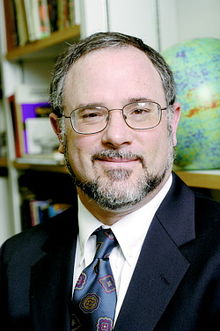- Charles L. Bennett
-
Charles L. Bennett (born November 1956) is an American observational astrophysicist and the Alumni Centennial Professor of Physics and Astronomy at Johns Hopkins University.[1] He is the Principal Investigator of NASA's highly successful Wilkinson Microwave Anisotropy Probe (WMAP).[1] Prior to 2005, Bennett was a Senior Scientist for Experimental Cosmology, Goddard Senior Fellow, and Infrared Astrophysics Branch Head at the NASA Goddard Space Flight Center.[1] Bennett was at the Carnegie Institution of Washington's Department of Terrestrial Magnetism during the summers from 1976 to 1978.[1]
His National Academy of Sciences (NAS) membership citation states, "As leader of the Wilkinson Microwave Anisotropy Probe (WMAP) mission, Bennett has helped quantify, with unprecedented precision and accuracy, many key properties of the universe, including its age, the dark and baryonic matter content, the cosmological constant, and the Hubble constant."[2] Membership is a great honor bestowed upon the most distinguished scholars in engineering and the sciences. [3] He was awarded the National Academy of Sciences Henry Draper Medal in 2005 [4] and the Comstock Prize in Physics in 2009 [5], both for his leadership of WMAP. Bennett received the Harvey Prize [1] in 2006 for, "the precise determination of the age, composition and curvature of the universe." Bennett shared the 2010 Shaw Prize in astronomy with Lyman A. Page,Jr. and David N. Spergel, both of Princeton University, for their work on WMAP. [6]
Bennett is a Fellow of both the American Association for the Advancement of Science and the American Physical Society.[1] In 2002, ISI named him the most Highly Cited Researcher in space science worldwide.[1] He is an author of the top two "Super Hot Papers in Science" published since 2003.[2] In 2004, he was elected a Fellow of the American Academy of Arts and Sciences.[7]
Before leading WMAP, Bennett was the Deputy Principal Investigator for the Differential Microwave Radiometers (DMR) instrument on the Cosmic Background Explorer (COBE) mission that discovered the anisotropy of the cosmic microwave background radiation. The Cosmic Background Explorer (COBE) Science Team also precisely measured the spectrum of the cosmic microwave background radiation.
Awards
Bennett's awards include:[1]
- 2010 Shaw Prize in Astronomy
- 2009 Comstock Prize in Physics of the National Academy of Sciences
- 2006 The Harvey Prize of the Technion
- 2006 Gruber Cosmology Prize (awarded to John Mather and the COBE Team for "ground-breaking studies confirming that our universe was born in a hot Big Bang.")[3][4]
- 2005 Draper Medal of the National Academy of Sciences
- 2005 Rotary National Award for Space Achievement (Mid-Career Stellar Award)
- 2004 NASA Exceptional Scientific Achievement Award (for WMAP)
- 2003 NASA Outstanding Leadership Award (for WMAP)
- 2003 John C. Lindsay Memorial Award for Space Science
- 2001 Popular Science “Best of What’s New” Award in Aviation and Space for WMAP
- 1992 NASA Exceptional Scientific Achievement Medal (for COBE)
Education
1978 B.S. degree in Physics and Astronomy cum laude with High Honors in Astronomy from the University of Maryland, College Park[1]
1984 Ph.D. in Physics from the Massachusetts Institute of Technology [1]
References
- ^ a b c d e f g h i "Brief Biography of Charles L. Bennett". Johns Hopkins University. http://cosmos.pha.jhu.edu/bennett/bio.html. Retrieved 13 February 2011.
- ^ "Charles L. Bennett, Johns Hopkins University". National Academy of Sciences. http://www.nasonline.org/site/Dir/1825620335?pg=vprof&mbr=1006626. Retrieved 13 February 2011.
- ^ "National Academies members". National Academies. http://www.nationalacademies.org/memarea/. Retrieved 13 February 2011.
- ^ "Henry Draper Medal". National Academy of Sciences. http://www.nasonline.org/site/PageServer?pagename=AWARDS_draper. Retrieved 13 February 2011.
- ^ "Comstock Prize in Physics". National Academy of Sciences. http://www.nasonline.org/site/PageServer?pagename=AWARDS_comstock. Retrieved 13 February 2011.
- ^ "Announcement and Citation - Astronomy - 2010". Shaw Prize. http://www.shawprize.org/en/shaw.php?tmp=3&twoid=67&threeid=169&fourid=238. Retrieved 13 February 2011.
- ^ "Book of Members, 1780–2010: Chapter B". American Academy of Arts and Sciences. http://www.amacad.org/publications/BookofMembers/ChapterB.pdf. Retrieved June 15, 2011.
- http://physics-astronomy.jhu.edu/people/faculty/
- http://www.nasonline.org/site/Dir/1704002876?pg=vprof&mbr=1006626&returl=http%3A%2F%2Fwww.nasonline.org%2Fsite%2FDir%2F1704002876%3Fpg%3Dsrch%26view%3Dbasic&retmk=search_again_link
- http://cosmos.pha.jhu.edu/bennett/bio.htm
- http://map.gsfc.nasa.gov/
- http://www.aaas.org/aboutaaas/fellows/
- http://www.aps.org/fellowship/1999/
Shaw Prize laureates Astronomy Jim Peebles (2004) · Geoffrey Marcy / Michel Mayor (2005) · Saul Perlmutter / Adam Riess / Brian P. Schmidt (2006) · Peter Goldreich (2007) · Reinhard Genzel (2008) · Frank Shu (2009) · Charles L. Bennett / Lyman Page / David Spergel (2010) · Enrico Costa / Gerald J. Fishman (2011)
Life science and medicine Stanley Norman Cohen / Herbert Boyer / Kan Yuet-wai / Richard Doll (2004) · Michael Berridge (2005) · Wang Xiaodong (2006) · Robert Lefkowitz (2007) · Ian Wilmut / Keith Campbell / Shinya Yamanaka (2008) · Douglas L. Coleman / Jeffrey M. Friedman (2009) · David Julius (2010) · Jules A. Hoffmann / Ruslan M. Medzhitov / Bruce A. Beutler (2011)
Mathematical science Shiing-Shen Chern (2004) · Andrew Wiles (2005) · David Mumford / Wu Wenjun (2006) · Robert Langlands / Richard Taylor (2007) · Vladimir Arnold / Ludvig Faddeev (2008) · Simon Donaldson / Clifford Taubes (2009) · Jean Bourgain (2010) · Demetrios Christodoulou / Richard S. Hamilton (2011)
Categories:- 1956 births
- American astronomers
- Fellows of the American Academy of Arts and Sciences
- Johns Hopkins University faculty
- Living people
- Massachusetts Institute of Technology alumni
- National Academy of Sciences laureates
- University of Maryland, College Park
Wikimedia Foundation. 2010.

